This Company is Determined to Transform U.S. Dental Health


According to the U.S. Centers for Disease Control and Prevention (CDC), almost one-third of American young adults suffer from untreated dental health problems like cavities. And over a third of these same adults didn’t visit a dentist during the past year. There are many reasons why many Americans forego dental care. Either they don’t have dental insurance, or if they do, their dental care benefits are easily exhausted. If they live in rural America, the closest dentist may be too far of a drive.
So many citizens skimp on or skirt dental care – or those who have the time or live in close proximity can drive to border cities like Los Algodones, Mexico (often called “Molar City”) to score dental care at a fraction of the cost of what they’d pay in the U.S. The bottom line is that many citizens in the wealthiest country on earth aren’t getting the oral care they need.
DentaQuest, the dental health disruptor
One company that is trying to both transform and expand access to dental care is DentaQuest. Through several programs, including “Preventistry,” a four-pronged approach seeking to disrupt how dental care is delivered, priced and accessed, Boston-based DentaQuest is striving to remove dental care from its silo and integrate it into the U.S. health care system.
“I like to tell people that DentaQuest is a disruptive oral health company that is working to reinvent the system from the inside-out,” said Alison Corcoran, the company’s executive vice president and chief marketing officer. “At the top, we’re a nonprofit focused on driving systems change through policy and program development, philanthropy and innovation.”
The reason why our dental care and health care are separately paid for, accessed and managed is largely an accident of history. In a nutshell, barbers used to be the practitioners who delivered oral care services and surgeries, largely in part because they already had the tools on hand. As knowledge about human anatomy, including the jaw, increased, dentistry as a practice began to emerge in the 18th century; surgeries became part and parcel of medical care by the mid-19th century. Medical and dental training since has long been separated and evolved in separate silos.
How can we boost access to dental care?
So while oral health care at a macro level has largely improved over the past half century, too many Americans are still falling through the cracks when it comes to getting the care we need. And as we all know, when your mouth hurts, everything hurts – not to mention the fact that one’s oral health can have a huge impact on his or her overall health.
But there is optimism – it’s just that dental and health care professionals need to revamp how such care is delivered as we thank about what’s next in improving public health.
“We feel oral health problems are almost 100 percent preventable, but the system is set up to pay for intervention, instead of paying for prevention. And so that's really why we're trying to change the system,” explained Corcoran.
Programs such as Preventistry are part of what Corcoran described as a five-point plan that could help improve and expand dental care to Americans. First of all, care needs to focus more on prevention, not just treatment. That in part relies on ensuring oral care is included rather than excluded when we approach an individual’s overall health. Third, DentaQuest is working on expanding oral health access, in part through programs like Medicare for elder Americans. Fourth, the company is working with schools and community organizations can help make oral care more accessible. And finally, DentaQuest envisions a system of “value-based care” that rewards positive and healthy outcomes rather than focusing on procedures.
It sounds complicated, and we cannot expect professions resting on centuries of precedent to turn on a dime. The good news, explained Corcoran, is that within the major stakeholders with a vested interest in the dental care sector – which includes dentists, employers, medical professionals, patients and Medicaid directors – there is plenty of agreement that things can and will change. “This not an insolvable problem,” added Corcoran, “People understand the opportunities that exist to fix it.”
Making dental care an important part of healthcare
One challenge is that most medical professionals have little knowledge about dental care fundamentals – and in fairness, that is because they weren’t trained. Yet at the same time, more emergency room doctors and nurses are seeing patients with dental needs come through their doors. There are two problems with this process: first, this is hardly a system that is sustainable in the long run, and frequently, it turns out that many of these visits are not necessarily emergencies but can be taken care of in a dental office. But again, questions about access and affordability arise; further integration of medical and dental care would help solve this ongoing challenge.
“We want to collaborate with primary care providers to provide them with protocols and approaches to identify oral care issues early on. We also want to connect primary care physicians and dentists with community health workers,” insisted Corcoran. “It's a question of raising awareness and making sure physicians and nurse practitioners have the ability and the confidence to understand what’s happening in their patient's mouths.”
The result is a company taking a stand; in the case of DentaQuest, it’s through disruption. Part of this plan is what the company calls its MORE (medical oral expanded care) initiative, which seeks to provide preventive oral health services in primary care medical offices to underserved communities. The testing of what the company describes as “patient-centered referral systems” between both primary care and dental care teams is also part of this program. To date, this program has rolled out in community health centers in rural Colorado, Oregon, Pennsylvania and South Carolina.
More access to affordable dental care, more opportunities to take care of one’s health in rural areas and less complicated system boosting health and wellness? DentaQuest’s strategy to work within the system in order to make it more equitable and accessible offers other health care and insurance companies a template as to how to improve public health – and their reputation with consumers.
Image credit: Pixabay
Danone Wants To Start a Food Revolution


You may not know it but the global food and beverage company Danone is in the midst of inciting a revolution. But unlike the last revolution that took place in the French multinational’s home country, this one is non-violent—it’s about reconnecting people with the food they eat and building a healthier world through food.
Launched in 2017, Danone’s One Planet. One Health. campaign revved up in New York this week where the Danone Institute North America—a not-for-profit established by Danone North America—announced the winners of its inaugural One Planet. One Health. grant program. TriplePundit had an opportunity to meet the grantees, who represent transdisciplinary teams from across the United States and Canada charged with designing, implementing and evaluating actionable, community-based projects for sustainable food systems. Their objective: Inspire local communities to join the food revolution by moving away from standardized food systems to new models based on local diets and leveraging local sourcing.
The winners—all represented at the launch event this week—include:
- The University of Guelph (Canada), which will test the feasibility, acceptability and impact of a four-week food waste reduction intervention on household food waste and fruit and vegetable intake. The pilot project will provide 30 families with a Food Waste Reduction Toolkit that includes practical meal planning, food shopping and storage tips for parents and children, along with recipes that showcase strategies to use up foods before they spoil. Families also will participate in education and cooking sessions; receive meal planning worksheets, food shopping lists and information on food storage; and receive text messages to reinforce food waste reduction messages.
- The city of Minneapolis, together with Tamales y Bicicletas, Appetite for Change and the University of Minnesota, which will support climate change mitigation and food sovereignty by increasing year-round, energy-efficient food production in food-insecure neighborhoods through passive solar greenhouses. The project will plan, build and analyze energy use, cost, production of fresh produce, and community education from the greenhouses, with the goal of expanding hyper-local food production capability.
- Project New Village, together with San Diego State University and the University of California, San Diego, which will work to assess the feasibility and benefits of creating and sustaining a community of practice for residential, mainly low-income, food growers and farmers. The project will help residential food growers build their capacity to grow and sell their food, foster regenerative agricultural practices, build agricultural business and economic skills, and identify local outlets for the food they produce.
- Friedman School of Nutrition Science and Policy at Tufts University, which will assess the global warming potential and nutrition profile of local foods in Boston Public Schools. The pilot will facilitate transdisciplinary collaboration among schools, farmers, manufacturers and nutrition researchers to assess the potential nutritional and environmental benefits of including local options on school menus. Researchers will evaluate the nutritional density and global warming potential of the current lunch menu items and will work with local farmers and manufacturers to find alternate products that maintain the nutritional quality of the meals served while reducing their global warming potential.
“We all have a deep, personal relationship with food,” said Leslie Lytle, president of Danone Institute North America and professor at the Gillings School of Global Public Health at the University of North Carolina, Chapel Hill, at the event earlier this week. “We are incredibly inspired by this year’s applicants who are taking action in fostering more sustainable food systems that benefit their local communities. This type of work requires collaboration to make a meaningful impact, and we are excited to bring together these local teams, as well as experts in sustainability and nutrition, to help us foster a new generation of change agents.”
The four winning teams participated in a four-day workshop about sustainable food systems where they presented their proposals and communications plans to a panel of experts. In addition to the $20,000 in grants each winning team was awarded, Project New Village received an additional $10,000 prize for presenting the best communication plan for their project. Each team also received coaching by food systems experts and Danone Institute North America board members to facilitate implementation, communication and evaluation of their projects over the next 12 months.

More than public relations
It might be tempting to write off Danone’s One Health. One Planet. strategy as a marketing campaign. But that would be wrong. The company has taken significant steps in the past three years to align its core business strategy to its purpose-driven mission.
For example, globally, Danone says it's working to reduce the number of ingredients in its products and proposing new organic and non-GMO product lines. The company is close to achieving its 2020 goals to reduce the amounts of sugar, salt and saturated fats in its products, with nearly 90 percent of products sold in 2018 in “healthy” categories.
The company has also created “Manifesto” brands, which it says “pursue a purpose based on social, health and/or environmental issues that matter to its consumers and communities, and are committed to creating a positive social impact whilst delivering sustainable, profitable growth.” These brands—some of which are not sold in North America—include, but are not limited to, Evian water, Alpro oat drink, and the Bledina and Happy Family baby food lines. The company has also committed to make its packaging recyclable, reusable or compostable by 2025 and to achieve carbon neutrality by 2050.
In April 2018, Danone North America was certified as a public benefit corporation, and it remains the largest B Corp in the U.S. As reported previously on TriplePundit, Danone’s acquisition of WhiteWave Foods in 2016 was a steppingstone toward its B Corp and benefit corp status, bringing on board popular organic and non-dairy brands such as Silk, Earthbound Farms and Horizon. The company also accelerated what it described as its commitment to environmental and social responsibility, including a “pledge” to help dairy farms become more financially competitive and sustainable.
No company is perfect
In a recent benchmarking report published by the environmental NGO Ceres, Feeding Ourselves Thirsty: Tracking Food Company Progress Toward a Water Smart Future, Danone scored seventh out of 40 companies. The report found that, globally, Danone could do more to assess water risks facing its suppliers and take steps to support and incentivize suppliers to strengthen their water management practices.
While the report focused on Danone’s global operations, Danone North America has proactively created an independent advisory committee—chaired by Rose Marcario, CEO of Patagonia—to help ensure adherence to its environmental and social benefit goals. Other members hail from Greenmont Capital Partners, Tufts University, the School of Medicine at UCLA and B-Lab Europe.
While no company is perfect, Danone seems to be taking the right steps toward economic success and social progress. Other companies like Nestle, Unilever and Chobani are taking similar steps in their own journeys. Perhaps it’s time they join forces in the same revolution.
Image credits: Daria Shevtsova/Pexels, Toa Heftiba/Unsplash and Danone North America
Goal for 2020: Mobilize Employees For Lasting Change


Entering a new decade reminds me of how I started the last one. I quit. More specifically, I quit a corporate structure that didn’t prioritize my wishes as an employee to be able to contribute to the greater good. As an accounting auditor, my manager asked me not to volunteer with the American Cancer Society in order to work on weekends. I certainly understood the time sensitivity of IRS-related filings and how critical they were to the success and trustworthiness of the business, but I felt that eliminating cancer as a life-threatening disease was also important and deserved at least part of my attention.
So, with the knowledge that my desire for social good work did not align with corporate America’s need to maximize shareholder value, I decided to spend a year traveling and volunteering with social enterprises. The journey helped me realize the biggest unaddressed need in global development: a lack of investment in the people behind ideas.
Closing the 'pioneer gap' in social enterprise
There is no shortage of social impact projects that need professionals with skills. It’s called the “human capacity gap." This lack of skills is a big contributor to the pioneer gap, which shows that foundation and impact investment capital likes to flow to new moonshot ideas, and then to scaling organizations, not to ideas in the middle.
Those stuck in the pioneer gap (aka the Startup Valley of Death), don’t have access to the financial capital they need to grow. Their team members also don’t have access to resources to build their skills and know-how to make it to the next stage and continue their work.
Not only do business ideas stumble, but professional growth for those working in these organizations halts, too.
In retrospect, this should not have come as a surprise to me, as the same lack of investment in people is recognized in corporate and governmental environments. One of the top voices in corporate leadership development, Josh Bersin, claims the model is broken. Our global economy does not have a good history of investing in the people behind products and ideas, but that is starting to change.
My contribution to this change was co-founding MovingWorlds, which helps people grow as world-positive leaders through engaging in social impact projects that build on their skills while stretching them to grow. We found a self-sustainable way to mobilize people with skills to help share their skills with the teams behind world-changing ideas. In the process, those that give their skills are able to grow as leaders and identify more ways to create positive changes back at work. We’ve partnered with corporations like Microsoft, Tableau, Kering, Avanade, Bookin and more who believe that working professionals have the skills and know-how to help scale social impact ideas when financial capital is too risk averse to support the needed change.
Business with a human focus
In January 2019, Larry Fink, CEO of one of the world’s largest investment banks, BlackRock, declared that clients must “contribute to society, or risk losing our support." A few months later, the Business Roundtable modified a 20-year-old mission statement on the purpose of business, moving away from outdated thinking that businesses only exist to maximize shareholder wealth and asserting that they must also exist to benefit their employees, supply chain, and the communities where they operate.
The 180 CEOs that signed the Business Roundtable's new purpose statement—including from Amazon and PepsiCo—realize they no longer have a choice.
According to Deloitte’s 2019 Human Capital Trends annual report, this year marks the rise of the social enterprise, where a business model combines profit-making through activities that respect and support the environment and its stakeholder network. According to Deloitte, the “Intensifying combination of economic, social, and political issues is forcing HR and business leaders to learn to lead the social enterprise—and reinvent their organizations around a human focus.”
At a human level, this makes sense. People want to know their work matters, and perhaps there is no better way than connecting employees to the societal benefit of their work to help them see how their company, and the work they do within it, matters. As PwC observed in a recent report entitled Making work more meaningful, “Employees today are looking for a work experience that is optimized for meaningful work and personal fulfillment, and encourages a growth mindset and generosity."
In its 2019 Global Trust Barometer, Edelman explained: "Employees are ready and willing to trust their employers, but the trust must be earned through more than ‘business as usual.’ Employees’ expectation that prospective employers will join them in taking action on societal issues (67 percent) is nearly as high as their expectations of personal empowerment (74 percent) and job opportunity (80 percent).”
Connecting employees to the societal benefit of their work shows them that their job and company matter. It also enables learning. The world’s largest study on purpose at work from Imperative shows that employees already want to do this, and it becomes the job of the company to make it easier for employees to find opportunities—and reward them for doing so.
How to mobilize employees to create lasting change
And herein lies the tectonic shift within companies. No longer can companies host a big giving campaign or mobilize employees for a global day of service in hopes of generating positive press and customer loyalty. Rather, companies are realizing that they actually have products, process, profits, partnerships and people that can be used in ways that contribute to the greater good. Furthermore, they are being pressured to make sure that these are delivered in ways that don’t propagate inequalities.
As Patagonia declares in its mission statement: “We know that our business activity—from lighting stores to dyeing shirts—is part of the problem. We work steadily to change our business practices and share what we’ve learned. But we recognize that this is not enough. We seek not only to do less harm, but more good.”
At MovingWorlds, when we partner with companies that then mobilize employees to contribute to a social impact project with their core skills, we see that nearly all employees return with insights about how to improve their team’s collaboration and potentially even the company’s products. See the program we designed and operate for Microsoft, MySkills. This virtuous cycle repeats, with the added benefit that every employee who engages sees how the company is a real contributor to society, but then also sees ways to improve things at the company so that it can do even more.
Perhaps the most important lesson we’ve learned is that these employer-sponsored experiences are just the start of meaningful change. Certainly our data shows that the projects provide a meaningful impact to hosting organizations and to receiving volunteers, but the long-term impact is even more important.
By providing ongoing guidance, creating alumni communities and nurturing the creation of innovation reports, employees are emboldened to return home and work to create lasting change. As just one example, Ruchi, a product manager from eBay, returned from a social impact experience, and within two weeks, started working on a new pilot to help women artisans in disconnected communities find their way onto eBay, which has massive impact and ROI potential for all parties.
As 2020 comes into view, we know that the interest of employees to engage in social, civic and environmental factors will grow, and it will be up to companies to harness this energy for triple-bottom line performance—or suffer the losses that come with losing the best talent.
Image credit: You X Ventures/Unsplash
More Companies Are Committed to 100 Percent Renewable Energy: Is It Enough?


The push for 100 percent renewable energy is growing among multinational companies. More than 200 of them have formally committed to 100 percent renewables through the RE100 initiative organized by The Climate Group. However, as the COP25 climate talks in Madrid get under way, it is important to keep in mind that just 20 global enterprises are responsible for more than a third of all greenhouse gas emissions, and none of them are part of the RE100 effort.
Multinationals and 100 percent renewable energy
The RE100's focus on multinational companies is important because decisions made at the top can ripple out across the globe, potentially impacting government and non-government policy in many jurisdictions instead of just one.
Earlier this week, the RE100 initiative ran the numbers on its more than 200 members and reported that almost half of them are positioned to influence policymakers, utility companies and other stakeholders to accelerate the renewable energy transition.
The group of 200 has set ambitious goals. The average date for achieving 100 percent renewable energy is 2028, and 75 percent of the group plan to be powered entirely by renewables by 2030 at the latest.
Collectively, they are well on their way. A third of RE100 members have already topped 75 percent renewables, and more than 30 are already at 100 percent.
The RE100 movement has also grown globally. At its launch during Climate Week NYC in 2014, RE100 attracted interest mainly from companies headquartered in Europe and North America, as well as India and China. More recently, the organization’s influence has spread into the Asia Pacific region, including Australia and Japan.
Overall, interest in the RE100 has accelerated. Membership grew by more than a third over the past year, more than 40 percent of that growth consisting of companies headquartered in the Asia Pacific region.
Why renewable energy?
The RE100 report also notes several significant trends driving the interest in 100 percent renewable energy.
Paul Simpson, CEO of the carbon-tracking organization CDP (a partner in the RE100 initiative), explains that “companies are now making the shift because it makes business sense—in part due to changing expectations from their key stakeholders—be that investors, customers or employees.”
That conclusion is backed up by an RE100 survey of its members. Some key figures are:
- 87 percent cite customer expectations as "important" or "very important"
- 76 percent say the same of shareholder requests
- Over half identified benefits in terms of employee satisfaction and staff retention
- 80 percent cite cost savings as an "important" or "very important" driver, despite challenges in certain markets
Along with being an impactful addition to corporate citizenship profiles, renewable energy commitments are already having a positive influence on utilities and local energy policy: More than 25 percent of the clean power sourced by RE100 members involved adding new renewable energy capacity to the local grid, according to the report.
Two-thirds of corporate members are planning to implement this “impactful procurement” approach in the coming year. And 44 percent say they are already influencing their electricity suppliers, compared to 36 percent who said the same last year.
The 800-pound gorilla in the COP25 room
All of this is encouraging, but business-as-usual on climate action is no longer acceptable. With the impacts of catastrophic climate change already falling on parts of the globe, the pace of action must increase significantly, advocates say.
Unfortunately, as RE100 notes, the ambitious intentions of global companies are not enough to counteract the foot-dragging among government policymakers and other companies still lagging behind.
This circles around to that group of 20 companies with the highest greenhouse gas profiles, as identified by researchers at the Climate Accountability Institute. Unsurprisingly, every company on the list is a major global coal, oil or gas stakeholder, so it’s also not a surprise that none of them have committed to 100 percent renewables.
More to the point, 12 of the companies on the list are government owned, and these firms alone have contributed 20 percent of global greenhouse gas emissions since 1965, according to the Institute. That direct intertwining of national interests and fossil fuel investment certainly complicates matters for COP25 negotiators.
In a report on the new research, last month The Guardian contacted all 20 companies on the list regarding their climate policies. Only eight companies responded. Of that group, only PetroChina and Brazil’s Petrobas represented the cohort of state-owned companies.
The refusal of most of the state-owned companies to discuss their climate policies with The Guardian does not bode well for COP25.
From climate goat to climate hero, but the question is: How fast?
Results from the seven investor-owned companies that responded to The Guardian inquiry are somewhat more encouraging.
Shell, for example, stated: “We fully support the Paris Agreement and the need for society to transition to a lower-carbon future,” noting that it has “already invested billions of dollars in a range of low-carbon technologies, from biofuels, hydrogen and wind power, to electric vehicle charging and smart energy storage solutions.”
Chevron replied in a similar vein, as did Total, ConocoPhillips, BHP and Peabody Energy.
Even ExxonMobil acknowledged to the Guardian that “we believe climate change is a serious issue,” though the company’s history of contributing to misinformation around climate change indicates otherwise (legal issues may also be a factor in the company’s recent change of heart).
The harsh truth is: If the need for climate action is urgent, then efforts like RE100 are not enough. Investor-owned fossil fuel companies must put real dollars behind their purported support for decarbonization, and nations that own fossil interests must make that commitment as well.
A list of the 20 companies profiled by The Guardian is available here.
Image credit: Andreas Gücklhorn/Unsplash
A Year in Purpose: The Top 10 Trends of 2019


(Purpose trend No. 9 in action: U.N. Secretary-General António Guterres does an Instagram live interview—his first ever—with 16-year-old climate activist Greta Thunberg at the Vienna International Centre in May 2019.)
By Alison DaSilva and Whitney Dailey
2019 will be regarded as the year that corporate purpose truly went mainstream. As the year draws to a close, we look back at so many moments in time that, together, ladder up to a seismic shift in the role of business in society.
We witnessed Gen Z elevate the response to the climate change crisis, CEOs redefine the purpose of a company, ESG dominate shareholder calls, and employees walk out of their places of work over issues that matter to them personally.
To capture the top trends of 2019, we reviewed and analyzed a year’s worth of purpose-driven news, activities, campaigns and announcements. And while there is still work to be done, these signs are showing us that purpose is not just here to stay, but a new normal.
1. Climate urgency takes center stage
The United Nations kicked off 2019 by reporting that we only have 11 years left to prevent irreversible damage from climate change—and companies responded swiftly by accelerating their goals and commitments.
Companies including Ben & Jerry’s*, Badger Balm, Burton and SodaStream closed their doors on September 20 to allow their employees to participate in the Global Climate Strike. And Mars* launched its #PledgeForPlanet initiative to achieve 100 percent renewable energy in its operations by 2040. We also saw 87 companies commit to lead the global push to cap temperature rise at 1.5 degrees Celsius ahead of the U.N. Climate Action Summit in September.
2. CEO activism goes mainstream
181 CEOs redefined the purpose of a corporation this year with a statement from the Business Roundtable, but this was just one example of CEO engagement and activism.
Walmart CEO Doug McMillon entered the gun control debate, and Dick’s Sporting Goods* CEO Ed Stack revealed the company destroyed $5 million worth of guns it had agreed to take off shelves. In the realm of health and gender, in 2019, more than 180 CEOs opposed state efforts to restrict reproductive rights including the heads of Square, Diane von Furstenberg, Ben & Jerry’s* and Bloomberg.
3. ESG extends beyond wall street
The importance of environmental, social and governance (ESG) metrics reached record highs in 2019 thanks to increased interest from investors.
According to Deloitte research published this year, more than 80 percent of mainstream investors now rely upon ESG disclosures to make decisions. Major ratings organization S&P Global Ratings also announced that it will include ESG sections within corporate credit rating reports.
As investment guided by ESG criteria continues to rise to $20 trillion in assets under management around the globe—comprising a quarter of all professionally managed investments—investors have become critical influencers in accelerating responsible business practices.
4. Gender identity opens opportunities for expression
As consumers look to align themselves with companies with values similar to their own, organizations are looking to take a more inclusive approach to gender identity and expression.
Mastercard launched True Name, a card that allows card owners to use their chosen or true names without requiring a legal name change to alleviate challenges for transgender or non-binary customers. Meanwhile, Mattel embraced inclusivity when it launched what it calls the world’s first line of gender-neutral dolls.
We also saw a host of companies announce more progressive employee benefits for individuals identifying as transgender or non-binary. And this spring, corporate big-hitters like Hilton, Sony and Viacom joined a Los Angeles area transgender job fair, showing their support for a community that can often face discrimination in the job search process.
5. Frictionless giving gains traction
As technology becomes more embedded in our everyday lives, giving to organizations in-the-moment has become even easier.
Earlier this year, Google announced voice-controlled donations can now be made through Google Assistant on any Google-powered digital device by giving the command. Meanwhile, Instagram unveiled a new donation sticker as part of Instagram Stories, allowing individuals to donate immediately after viewing compelling content. And as of September, Facebook had reached $2 billion worth of donations through fundraisers on the platform.
6. Fashion accelerates sustainability
With research pointing to over half (52 percent) of consumers in the U.S. and U.K. demanding clothing retailers become more sustainable, the fashion world continues to respond in spades.
Prada committed to phase out virgin nylon by 2021, and Zara pledged to make all of its clothing from 100 percent sustainable fabrics by 2025. In an effort to help consumers make more sustainable shopping decisions, Urban Outfitters announced a clothing rental subscription, and Nordstrom launched an online shopping category called “sustainable style.”
7. Equity advances the D&I conversation
While diversity and inclusion has been gaining importance for many years, 2019 marked the year equity gained a seat at the table. Equity represents fair access and advancement for all people, while also striving to eliminate barriers to full participation of some groups.
Acknowledging a gap in opportunities, Hennessy recently launched the Hennessy Fellows program in partnership with the Thurgood Marshall College Fund. The program welcomed 10 MBA students from historically black colleges and universities (HBCUs) to engage with executive leaders at Hennessy and other major corporations, forming important relationships with senior leaders and creating champions for career progression.
8. Plastics take precedence
Plastics took center stage in 2019. In fact, we’d be hard pressed to find a company that hasn’t made a major plastics commitment this year. And companies are getting creative in solving for plastic waste: Tesco is testing a plastic-free produce aisle, Corona is accepting trash plastic as payment for beer, and Budweiser created a soccer field in Sochi, Russia, made entirely of recycled plastic cups collected after the 2018 FIFA World Cup.
9. Youth leads a movement
Generation Z came on the scene en force in 2019. And for proof Gen Z activists are becoming household names, look no further than Greta, Emma or Zendaya. This may not come as a surprise when research reveals that 87 percent of Gen Zers are inspired when they see their peers take a stand on issues.
Savvy organizations are tapping into the power and voice of these young leaders. Case in point: Arbor Day Foundation formed an unlikely partnership with YouTube celeb Mr. Beast to celebrate his reaching 20 million subscribers by raising $20 million to plant 20 million trees by January 1, 2020.
10. Employee activism increases
A trend that gained traction in 2018, employee activism is now firmly entrenched in the corporate responsibility purview. This year we saw Walmart employees stage a 15-minute walkout and moment of silence to share their views on the sale of guns in stores, Wayfair employees take to the streets in protest of furniture sold to detention centers holding migrant children, and a worldwide walkout from Amazon to push the company toward stronger environmental practices.
While not all employers heeded the demands, these moments in time brought a major spotlight to employee grievances and proved that individuals will no longer check their values at the workplace door.
The bottom line: Purpose is the new normal
Through taking stock of 2019, it’s clear that the building blocks are in place for a more equitable, impactful and brighter future. The time is now, and momentum is on our side. We look forward to a new year with bolder announcements and more innovative advancements to drive our industry forward.
*Porter Novelli/Cone client
About Alison DaSilva: As executive vice president and lead of Porter Novelli’s award-winning Corporate Social Responsibility group, Alison’s twenty five years of experience spans strategic planning and goal setting, reporting, social impact, employee engagement, public/private partnerships, stakeholder engagement, reporting and sustainability communications. Her passion is grounded in uncovering insights that help organizations create breakthrough campaigns that deliver a business, brand and societal return.
About Whitney Dailey: Whitney Dailey guides agency brand strategy, marketing and thought leadership as Vice President, Marketing/Research & Insights at Porter Novelli. With a strong background in Purpose, CSR and social impact issues, Whitney positions the agency for growth while furthering its legacy as a pioneer in Purpose communications
Image credits: UNIS Vienna and appaIoosa via Flickr
Wind Could Power 30 Percent of Global Electricity Production By 2050


Wind energy will supply 30 percent of all global electricity production by 2050, with 12 percent coming from offshore wind and 18 percent from onshore wind, Norwegian risk management provider DNV GL predicts in a new report.
Wind power has become a major contributor to the clean energy transition in the U.S. and across the globe, and the industry has made significant advances both in technology and in bringing costs down.
Wind and solar are both on their way toward grid parity with fossil fuels, meaning they will be able to generate power at a leveled cost of electricity that is equal to or less than the price of power from the electric grid, which is dominated by fossil fuel-generated electricity. In other words: Wind and solar will cost the same or less than coal and natural gas—as early as the mid 2020s in some countries.
An added perk: Water savings from wind energy
Bringing wind energy’s costs down has a direct benefit to both human and environmental health. Wind energy does not produce greenhouse gas emissions when generating electricity and it uses no water, a significant benefit over the very thirsty fossil fuel and nuclear energy sectors.
Wherever wind (or solar) can be deployed and coal and natural gas can be ramped down, water needed for generating electricity can be used for other needs, such as municipal drinking water or maintaining environmental flows in bodies of water to protect ecosystems. In many places, where climate change means increased water stress, this is an important factor to consider.
As the technology matures, costs have come down and more offshore wind is being deployed worldwide. The support in the U.S. seems to be growing slowly but surely. Further, the biggest markets developing are in places like the west coast of the United States, Spain, France, Asian countries like Japan, and island communities, all of which are facing increasing stressful water quantity issues.
Wind turbines and extreme weather
There is a concern about offshore wind in the face of climate change—namely, how well turbines can withstand extreme weather.
Wind speeds are considerably faster offshore than onshore, and recent hurricanes have seen winds up to 185 miles per hour. Models have shown that offshore turbines may not be able to withstand hurricane winds, and recent experience demonstrates that the more extreme hurricanes of the past few years have battered turbines—for example, in Puerto Rico during Hurricane Maria.
Still, more resilient energy systems are needed overall. Even if a turbine survives a storm and the traditional grid still goes down, there will be nothing for the turbine to connect to in order to provide usable energy. Thinking about the system as a whole is imperative.
However, the industry knows this challenge exists and is rising to meet it. The U.S. Department of Energy is funding research and development into improved turbine technology that can withstand the high wind speeds. And DNV GL's report points to a recent industry collaboration called Alleviating Cyclone and Earthquake Challenges for Wind Farms (ACE) that will define safety levels for wind farms and create best practices for the entire offshore wind industry. A further plot twist, however, is that offshore wind turbines might actually reduce precipitation from hurricanes on land.
In its report, Offshore Wind: The Power to Progress, DNV GL notes that the U.S. alone has an offshore wind potential of 2,000 gigawatts, which is double the nation’s current electricity use.
Industry is already addressing the technology needs of wind to withstand extreme weather, and as more wind energy is generated—both onshore and offshore—it can help to reduce water stress and carbon-altering emissions. Offshore installations might just be the latest wind in clean energy’s sails.
Image credit: Flickr/United Nations Photo
Common Ground on Climate Change: U.S. Labor and Business Leaders Stand By Paris Agreement

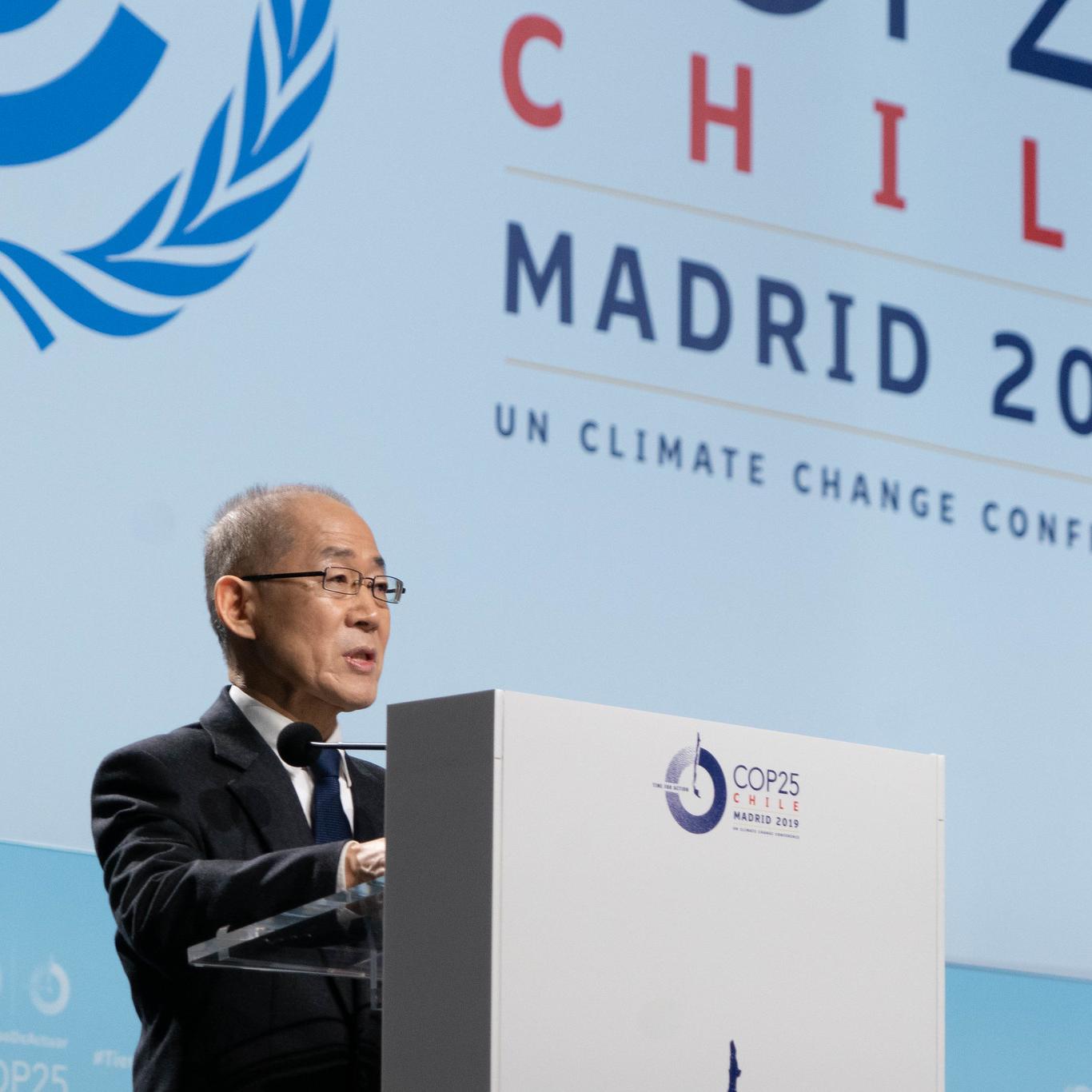
(Image: Hoesung Lee, chair of the Intergovernmental Panel on Climate Change, addresses the crowd on Dec. 2 at the U.N. COP25 climate talks in Madrid, where world leaders will continue to discuss and refine the Paris Agreement.)
With the Green New Deal percolating in the background, some U.S. policymakers are beginning to turn their attention to the impacts of climate change and economic decarbonization on workers and their communities.
Now the AFL-CIO, the largest labor union in the nation, has joined 75 leading CEOs in support of that trend. On Monday, they issued a joint statement that articulates how the Paris Agreement on climate change supports the emerging concept of a “just transition” toward a decarbonized economy—one in which social equity grows alongside environmental sustainability.
Sustainability and survival in the era of climate change
By connecting climate action with labor and social justice issues, the new joint statement makes it clear that planning ahead for upheaval in the labor market is just as important as accelerating the pace of decarbonization.
Globally, climate impacts are already feeding labor disruptions and political conflict, leading to a cascade of displacement and refugee crises in parts of the world.
U.S. businesses that seek a more stable, predictable environment for future ventures must create new alliances in the absence of a strong national policy on climate change.
Climate cooperation: strength in numbers
Though the new joint statement on the Paris Agreement is a domestic effort, it is positioned for global impact.
Along with its domestic affiliates, the AFL-CIO represents more than 12.5 million U.S. workers in fields as diverse as the performing arts and radio as well as key decarbonization sectors including agriculture, energy, transportation, construction, manufacturing and more.
In addition, AFL-CIO is an affiliate of the International Trade Union Confederation. Spanning 163 countries and territories, ITUC has 207 million workers on its roster.
At first glance the 75 CEOs represent a much smaller number. According to the joint statement, they collectively employ about 2 million people in the U.S.
However, many of the companies represented are the U.S. branches of global businesses. L’Oréal’s 11,000 U.S. employees, for example, form just one part of the company’s global workforce of 86,000.
The joint labor union and CEO statement on the Paris Agreement
The joint statement was released on Dec. 2 under the umbrella of a new group called United for the Paris Agreement. The timing is of critical significance, as it coincides with the opening of COP25, the United Nations climate change conference in Madrid, Spain.
U.S. President Donald Trump is still bent on pulling the U.S. out of the Paris Agreement, but many state and local policymakers are still dedicated to the decarbonization goals of the Agreement. The joint statement provides a powerful lever of support for those efforts as the U.N. climate talks get under way.
In their statement, AFL-CIO and the 75 CEOs make the case for affirming the Paris goals as a matter of national economic policy. They insist climate action is “what’s best for the economic health, jobs, and competitiveness of our companies and our country.” They also note that the Paris Agreement supports predictability in the private sector, because it establishes the kind of precise goals that provide for innovation and long-term planning.
Above all, the statement emphasizes that U.S. policy on climate change is out of step with public sentiment.
The signatories note that U.S. companies need to compete “under the shifting expectations of Americans.” And those expectations are coming into sharp focus as consumers, clients and other individuals seek out business with a strong sustainability profile. According to the joint statement, 77 percent of registered American voters support the Paris Agreement.
In addition, it counts more than 4,000 U.S. states, cities and businesses supporting the Paris Agreement.
Sustainability and a just transition
As for the need to work quickly toward a just transition, the statement focuses on the disruptive impacts of climate change, which have already manifested in parts of the world and in the U.S., too:
“Today, with record temperatures across the country, fiercer hurricanes pummeling coasts, more destructive wildfires, droughts and flooding disrupting the economy, we have no time to waste.”
The signatories draw a direct connection between supporting the Paris Agreement and supporting a just transition:
“We stand by our conviction that a commitment to the Paris Agreement requires a just transition of the workforce—one that respects labor rights and is achieved through dialogue with workers and their unions. Participation in the Paris Agreement enables us to plan for a just transition and create new decent, family-supporting jobs and economic opportunity.”
Think globally, act locally—but it’s complicated
This message may not reach into the Oval Office, but then again, most likely the president is not the intended audience. The message is one of support for local efforts to plan ahead for the workforce transition as the private sector sets aggressive decarbonization goals.
Together, the 75 CEO signatories represent companies that have business interests in practically every community in the U.S. The list includes Mastercard, CitiGroup, Microsoft, PepsiCo, the Coca-Cola Co., the Walt Disney Co. and Apple, among others.
The group of 75 also puts companies that are far ahead in the sustainability field on common ground with others that have much more catching up to do. For example, Patagonia and Levi-Strauss & Co. signed the joint statement. So have Cargill, Dow, and the global petroleum firm Total.
Another area of complication lies within AFL-CIO, which represents workers across all areas of energy production, including fossil fuels.
As the U.N. climate talks move forward, it will be interesting to see if AFL-CIO and the 75 executives balance these areas of conflicting interests and follow up on their joint statement with concrete plans for action.
Image: Flickr/UNclimatechange
New 'World War Zero' Campaign Pitches Climate Action For Everyone—Left, Right and Center
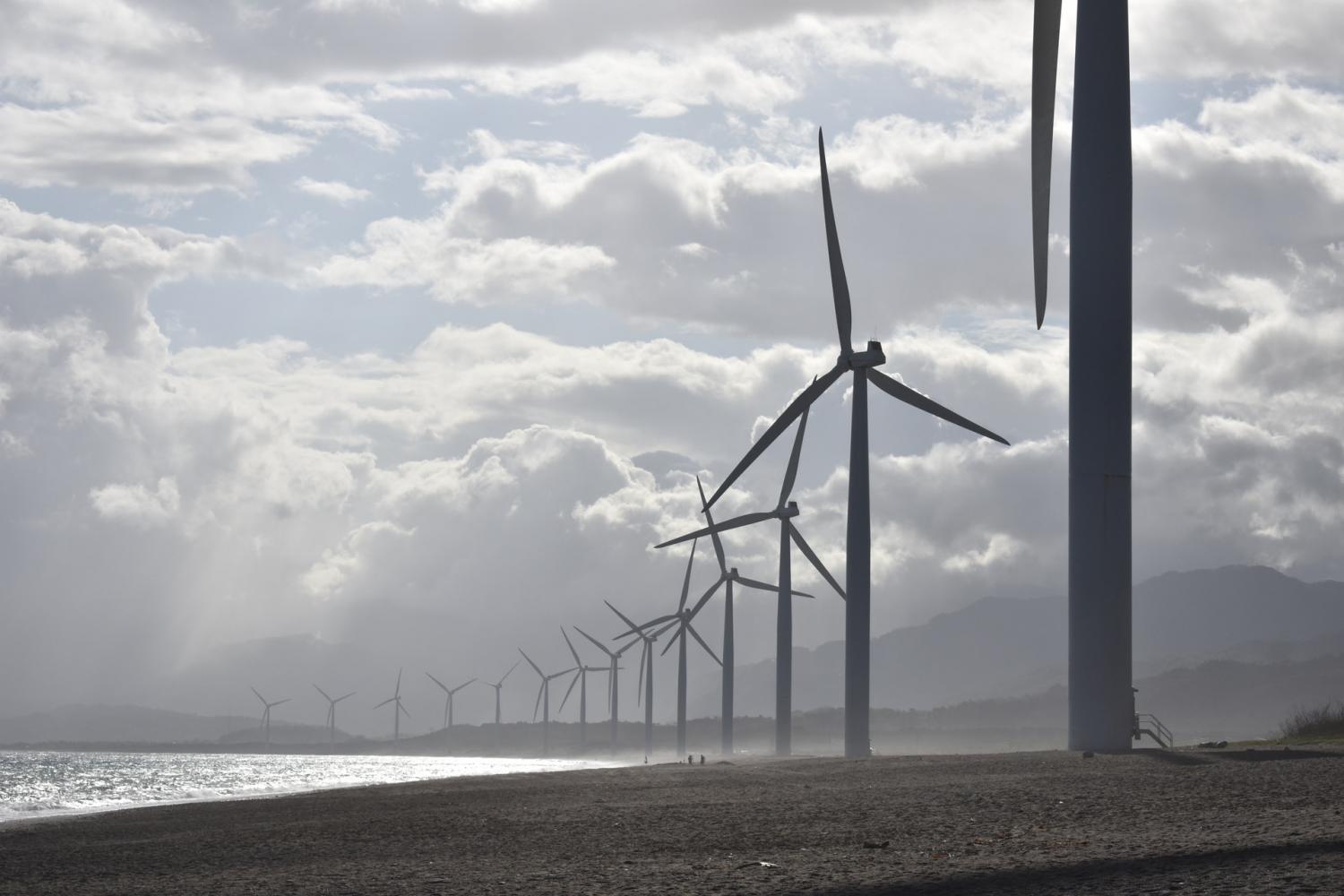

In a country where the leaders of one political party continue to deny the science behind climate change, it would seem impossible to form a bipartisan coalition aimed at accelerating the decarbonization of the global economy. Nevertheless, a new campaign called World War Zero has adopted an approach that just might work.
What is World War Zero?
World War Zero launched last weekend with the support of John Kerry, Arnold Schwarzenegger and other celebrities. The star power is certainly helpful in cutting through the media clutter, but there is an additional force driving the campaign.
Behind the list of famous names is a coalition with a strong bottom-line interest in the clean power transition—and in the threat climate change poses to national security.
The campaign is a partner of the American Security Project, a think tank aimed at encouraging a bipartisan approach to addressing threats to national security. In addition to climate change, the American Security Project lists terrorism, nuclear proliferation, energy challenges and economic wellbeing among its areas of focus.
The need to unite against common foes when U.S. interests are threatened would seem to go without saying. However, the problem is that today’s political leadership cannot agree on the nature of those foes.
Building consensus on climate change
The American Security Project attempts to achieve consensus by emphasizing the wider challenges of national security in today’s world:
“Gone are the days when a nation’s security could be measured by bombers and battleships. Security in this new era requires harnessing all of America’s strengths: the force of our diplomacy; the might of our military; the vigor and competitiveness of our economy; and the power of our ideals.”
That’s all well and good, but the problem is still how to bridge a political divide in which one side persists in denying the scientific consensus on climate change. That’s where something called the Business Council for American Security (BCAS) comes in.
As an affiliate of the American Security Council, BCAS provides the organization with a perspective on national security that can best be described through the lens of corporate social responsibility (CSR).
As expressed by the American Security Project, “Bringing the voice of enterprise into the national security dialogue will not only enhance ASP’s impact, it will enhance the role of business as a force for change.”
Business leaders are increasingly drawn to evidence that a strong corporate social responsibility profile is a necessary element in a successful company, regardless of the political affiliation of top executives.
As part of the CSR trend, business leaders have also helped to accelerate the renewable energy transition here in the U.S. and around the globe.
Connecting climate change and national security
From the perspective of corporate social responsibility and military readiness, climate change is not a partisan issue at all. It is an issue of fundamental national concern.
Last week, for example, the American Security Project called attention to the impacts of climate change on military installations, and the steps that the Department of Defense is undertaking to address those impacts.
In particular, the organization noted severe flooding at Offutt Air Force Base last spring and the impact of Hurricane Michael on Tyndall Air Force Base in 2018:
“Experts predict it will take years to rebuild both bases and cost billions of taxpayer dollars. In part due to the damage at Tyndall and Offutt Air Force Bases, the Air Force requested supplemental funding for this year, and an additional $3.7 billion for fiscal years 2020 and 2021.”
ASP further noted that “without the additional funding, the Air Force may need to forego regularly scheduled facility maintenance, ground combat aircraft, and cut flying time for non-deploying squadrons. Such cuts will affect military readiness and put U.S. national security at risk.”
Support our troops: Climate change edition
ASP’s focus on the military impacts of climate change gives new life to the shop-worn slogan, “Support our troops!”
With that in mind, the choice of World War Zero as the title of the new campaign is no accident.
The campaign appeals to business leaders, political leaders and the general public to unite against a common foe, as “unlikely allies with one common mission: making the world respond to the climate crisis the same way we mobilized to win World War II,” the organizers write.
If that approach seems too optimistic, maybe so.
However, World War Zero is underpinned by a solid platform of corporate leadership on clean energy, clean technology and climate action. And that leadership has already begun to move the needle on bipartisan political action.
There is still a long way to go, but the World War Zero campaign could help amplify the voice of corporate leaders who see climate action as the key to their companies’ ability to survive, and thrive, in the coming years.
Image credit: Jem Sanchez/Pexels
REI Opts to Lead Retailers Big Time on Shifting to the Circular Economy


There’s been a lot of talk about the circular economy, which generates more talk, more press releases, more events, more partnerships and then, more talk. But the outdoor gear and apparel company REI, well-known for its #OptOutside campaigns and staying closed on Black Friday, is also opting to expand the circular economy to its members and customers – and doing so aggressively.
The Seattle-based co-op is doing so by expanding its popular “garage sales” online. If you’re an REI member, you’re aware of the quarterly sales at many of its locations, at which lightly used or returned goods are sold at a steep discount. Disneyland would blush at those lines that are queued up long before those sales begin. Many outdoor enthusiasts, however, are located quite far from an REI location, and that demand for well-priced and used goods in part led the retailer to start partnering with Yerdle, a Northern California-based company that designs the online architecture allowing brands to resell returned or used items online.
“Partnering with Yerdle allows REI to build on the successes of its in-store garage sales and get niche product in the hands of people who can continue to use it,” said an REI spokesperson while TriplePundit toured Yerdle’s warehouse in Brisbane, California earlier this fall.
Walking around the cavernous Yerdle warehouse is akin to wandering around any apparel retailer’s fulfillment center, with a few notable differences. At Yerdle, the massive boxes that arrive are items that for the most part were returned by online shoppers. The vast majority of these items are in perfectly fine shape, but there’s no way REI (or other retailers like Patagonia that works with Yerdle) could sell those items again at full time.
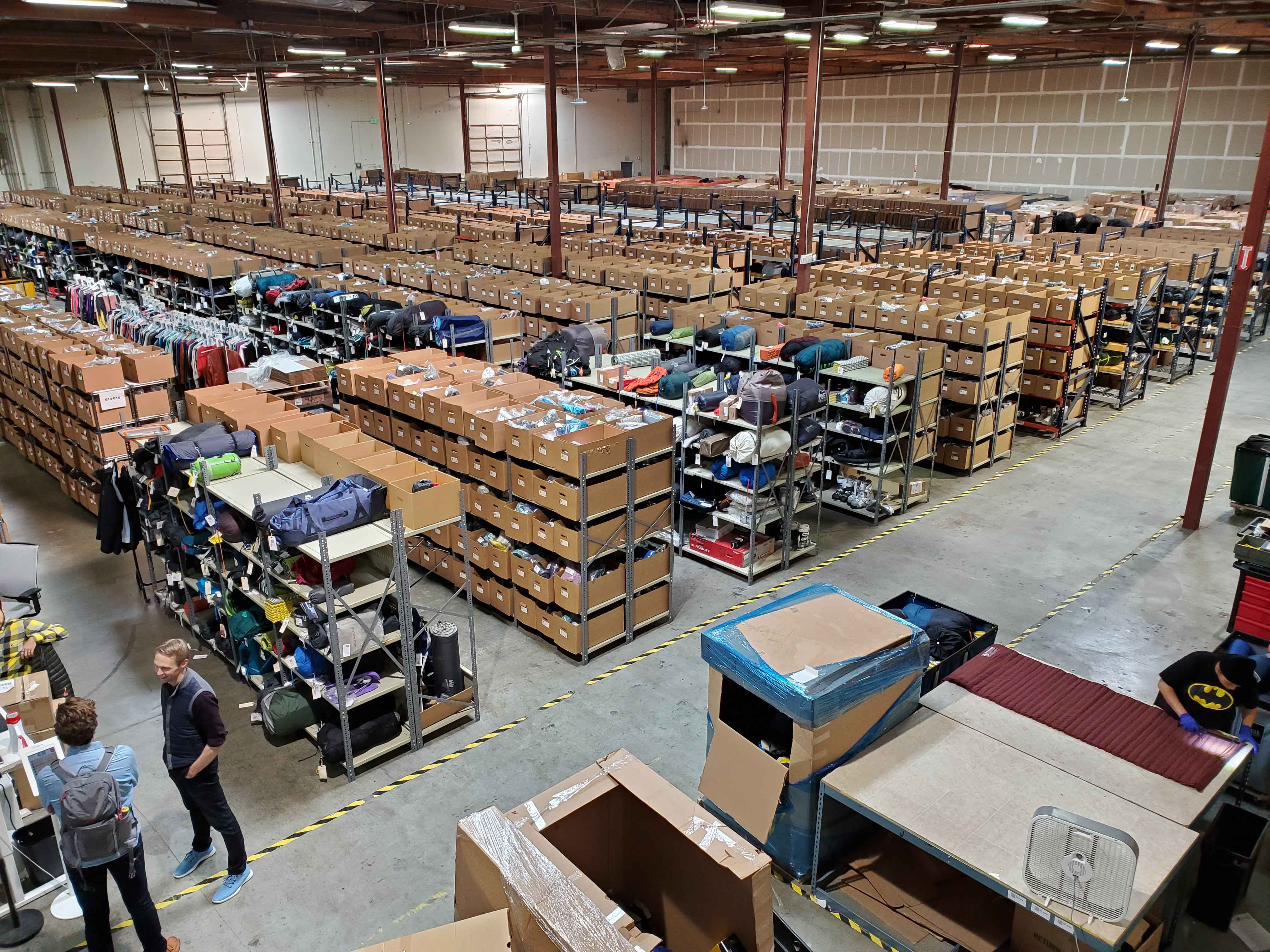
Photo: A view of Yerdle's warehouse in Brisbane, CA
Hence there is a team of Yerdle employees who is tasked with inspecting these items – and do everything from light cleaning to small repairs, to assessing the condition of these items for resale and then entering that data on a tablet. Other employees repackage and store the items until they are ready to be sold and shipped yet again. One highlight was watching a Yerdle photographer whose job it was to capture these items so they look attractive once they are posted on REI’s used gear and apparel website.
According to the company, REI is on track to resell nearly a million used items by the end of this year 2019, and this segment of its business is on target to nearly double in revenue in 2019 compared to the previous year. Over one-third of REI’s used gear and rental customers are brand-new members; and one-third of REI’s rental customers are millennials. The most popular products since this site launched have been camping goods such as tents and sleeping bags, hiking boots, women’s apparel and synthetic outerwear – understandable when you consider the cost of buying these items.
Perusing through REI’s used gear and apparel website is like surfing through any other retailers’ site – you can search by brand, color, size – as well as the condition of the product as well.
For those consumers such as the occasional campers or skiers who would rather not buy these items in the first place, REI also operates a rental service, which company representatives say is also quickly growing.
Currently, the company is piloting a buy-back program with Yerdle in which members can
buy, sell and trade in their unwanted used outdoor gear and apparel. At the moment this program is limited to members who the company has invited to test this online program.
For retailers keen on becoming part of the circular economy, REI offers ideas on how to words into action. Over past decade, various retailers on both sides of the pond have tinkered with recycling clothing and having clothing donation stations plunked within their stores. But the reality is that scaling up textile recycling has been a fitful experience at best – after all, if these programs were successful, we’d be hearing about them. There are huge hurdles to going circular by recycling textiles – changing consumers’ habits at an epic scale, making clothing out of blends that allow for effective recycling (if that cotton stretch t-shirt has 5 percent nylon, sorry, you’re out of luck) and having apparel companies agree to completely transform their supply chains.
But if we went back to quality products, took good care of them, and then allowed someone else to reuse and repurchase them, such a change could help mitigate the global garment industry’s environmental and social impacts. REI is off to a solid start – even if it falls short of its million-items goal this year, its achievements so far are nothing to sniff at.
Image credit: Leon Kaye
P&G, GE Join Forces to Encourage Girls to Consider STEM Careers
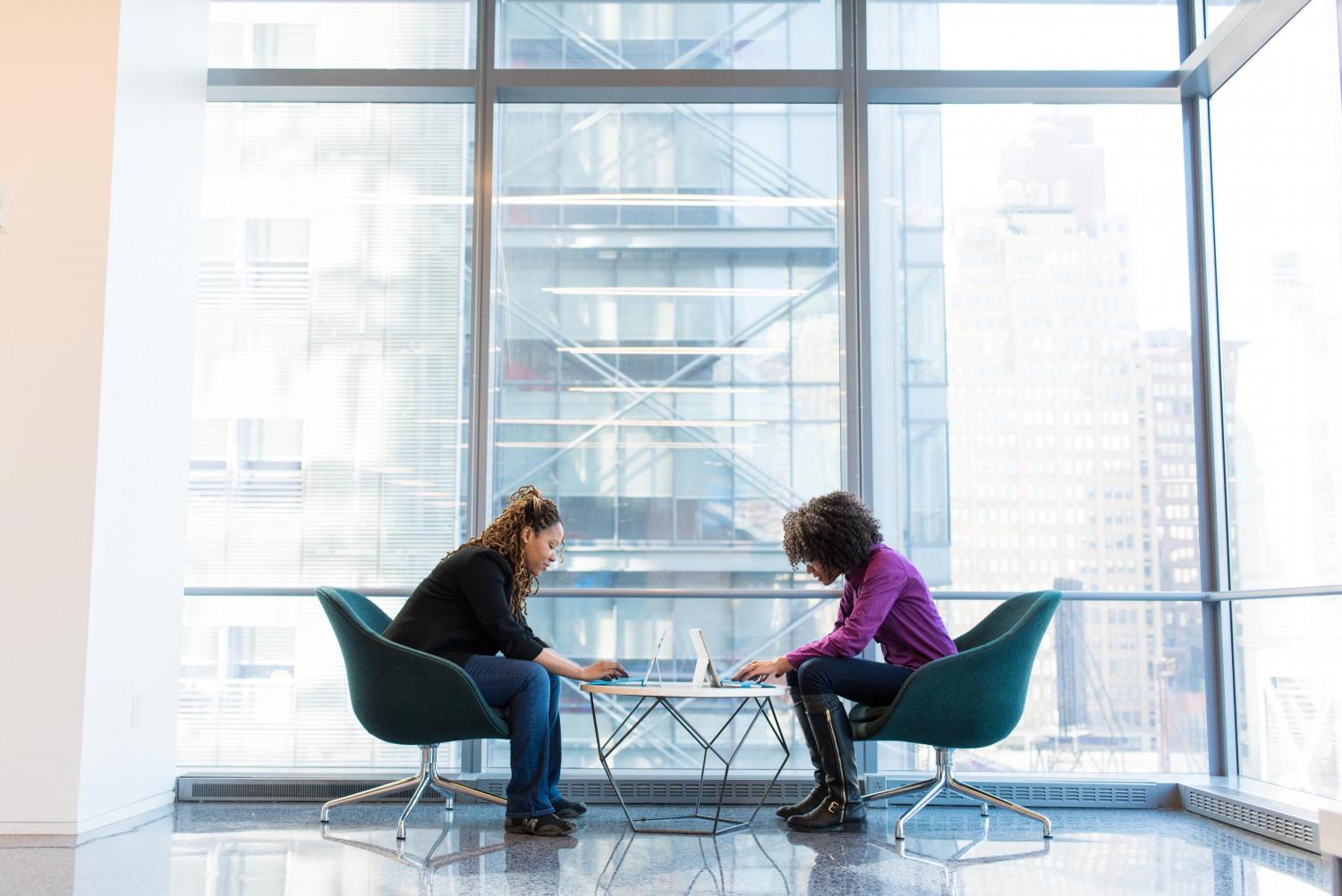
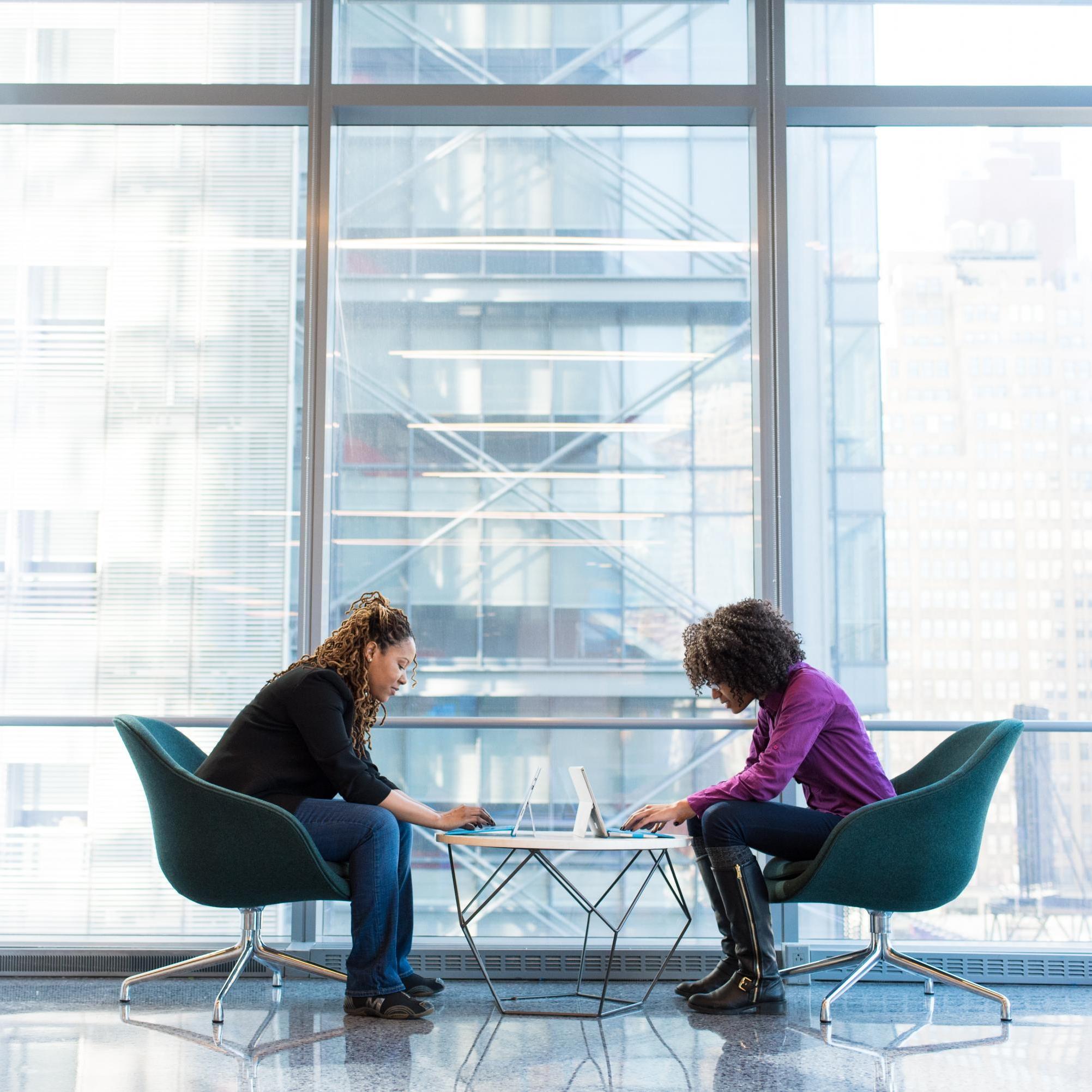
According to the U.S. Bureau of Labor Statistics, there will be well over 10.5 million jobs in STEM (science, technology, engineering and math) by 2028—and those jobs will pay almost 2.5 times the average salary. Most experts agree there will not be enough applicants to fill all these jobs in the coming years.
Despite the evidence that, yes, boys and girls have the same aptitude when it comes to subjects as math, there are also countless reasons why women are often discouraged from pursuing STEM-related careers. The “bro” culture in Silicon Valley (or “brogrammer” mentality), longstanding trends in higher education, companies failing to back up words with recruitment efforts, and the lack of female executives at tech and engineering companies are just a few reasons why women interested in STEM often end up pursuing other careers out of frustration. This keeps happening despite the fact many of the world’s leading companies say they are taking action to address this challenge.
To that end, Procter & Gamble joined forces with GE Aviation to hold a workshop for about 200 girls, grades six through nine, last month in Cincinnati, home to P&G’s headquarters. Other companies that participated included E&Y and Google.
An event for 200 students may seem like a drop in the bucket, but the point here is that an old adage applies: Get them while they’re young. There is no shortage of stories about boys being quick to raise their hands in class while social norms long discouraged the same type of academic enthusiasm in girls. Decades of convention will not change overnight. Hence the support that P&G and GE are offering for such events needs to be repeated, scaled up and, yes, publicized.
To P&G’s credit, the CPG giant is adopting other tactics to support STEM inclusion in the markets it serves, as well as include more women with STEM backgrounds in its ranks.
One program the company has launched takes care of another often overlooked demographic—women who have paused their career trajectories in order to raise kids or take care of a family member for health reasons. The company also supports girls' STEM education in the U.S. in partnership with Girls Who Code, as well as in other markets such as Cairo, Egypt, as summarized in its 2019 Citizenship Report released this week (page 109 for reference).
Here at 3p, watch for us to cover this trend more in 2020, because companies that strive to have an inclusive culture in what are traditionally male-dominated industries are doing the right thing for many reasons: It’s good for upward mobility, good for our economy, and can help make for a more energized and engaged workforce.
Image credit: Unsplash